Primitive game design. Turn-based card game development
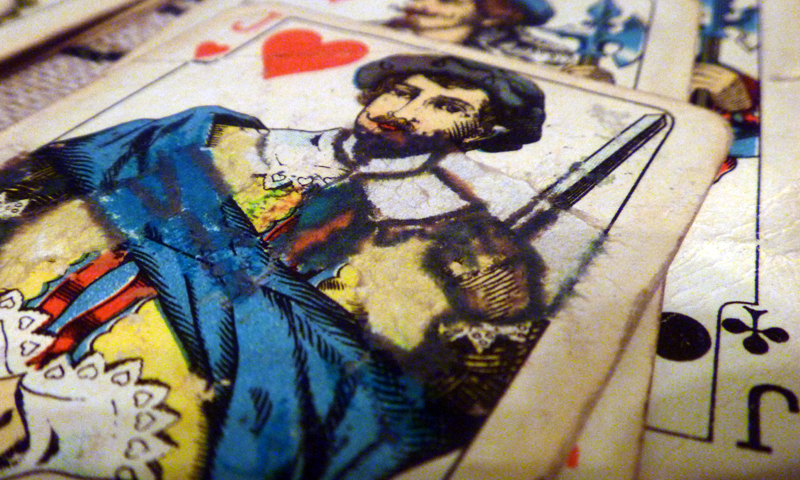
Motivated by reading the subject literature and several articles on the game design in general and how to finally get up from all fours and try to take the first steps, I decided that all that was required of me was to sit down and start working.
Let it be not an AAA project supported by millions of investments, but something more trivial and simple.
Card game. Addictive, interesting, not too complicated. And we'll see.
Under the cut - introductory, the beginning of the process and a lot of thought on the topic.
')
Before the start

When I was still a schoolboy, I perceived video games and desktops as a wonderful opportunity to escape from reality for a while and get distracted, while receiving a lot of unforgettable emotions and impressions. Not a few years have passed, and the perception has not changed. And sometimes, gathering with friends or simply highlighting a couple of hours in the evening, there arises the same unforgettable desire to briefly leave our real life with you and forget about all its problems.
I had the idea to make games a long time ago, but I didn’t know at all from which side to approach the process. Now the vast majority of all companies associated with game development in the first place requires experience. But where do you start taking it, if you don’t take it anywhere without it? A logical decision comes to mind - make the game yourself. And all would be nothing, but in order to make something more or less playable and beautiful, you need a team. No matter what child prodigy you are, it’s impossible to master the artistic, technical and conceptual parts at the same time (and I did not mention all of them). At least for the whole time of communication with various people, I have not met a single individual who has succeeded in such a trick.
No, I certainly tried to gather people “with fire in their eyes,” who were ready to work for the idea. But in order to maintain this fire, it was required, as I already understood later, something more than the phrase “Guys, let's try and do it!”. All fled, everyone had their own problems and excuses, and numerous multi-page concepts remained in the archives, waiting for the best days of triumph. I still believe that one day I will be lucky, and I will return to them with new powers.
In the meantime, I have some kind of gaming experience, understanding the basics, interesting, I think, thoughts that I want to share. Let it be the first step.
What will happen next? It is a logical question.
A lot of balancing, improvements, drawings. This is for starters.
In far perspectives: a toy for android and ios. But for now, let's not look so far.
Concept
I will lead the development in gradations from simple to complex. This will facilitate the understanding of the concept as such and noticeably simplify its modification in the future.
So. General provisions. What do I want from the game?
- Participation 2-4x players.
- The average batch length is ~ 10-12 minutes.
- The need to think about their actions in the process.
- A small playing field that can be expanded quite easily and quickly. Unique for each batch.
- Maximum possible replayability.
- Ability to expand and complement as desired.
I want to take as a basis a field formed from a mixed deck of cards (in the amount of 38 pieces. That is, a “regular” deck + 2 jokers. About them a bit later). Players will start in its “lower part” and will move in turn to move one “cell” forward in three possible directions, revealing the card after the card. Wins the one who most quickly pass the "maze". By passing, I mean overcoming the last row of cards. In the process of movement there will be an opportunity to run into traps, put a pig to a friend and in general in every way complicate the life of his neighbor and simplify it for himself. All this will be based on the interaction with the colors of the cards (red and black) and on the proper use of the found buns.
For a start, come down, I think. The first tests will show whether it is enough for the integrity of the gameplay. There are already ideas on how to complement the game, but at this stage of development we absolutely do not need it. Now it is necessary to work out the "skeleton", from which it will already be possible to go somewhere else in the future.
Playing field
Reflecting on the location and shape of the playing field, I went through several options. We have 38 cards. That is 36 + 2. Of the 36 cards "shirt" up, we form the playing field of a certain shape, and leave two cards "above" and "below". These are our "entrance" and "exit" from the maze. The first thought when I see the number “36” is the square of the number 6. That is, the field is 6 * 6 in size. Fortunately, every home has a good old block of cards of various attritions, which you can open and test on the spot our choice. So I did. I will not take pictures of this action, but I will schematically and with great pleasure demonstrate and analyze what happened.
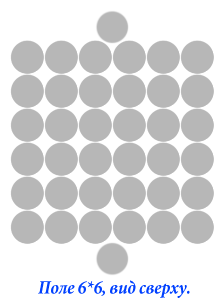
The mixing and layout of the maps took something in the region of a minute. At the same time I did not need to change my position in order to reach the last row of cards. This should make even the most lazy player (whom your humble and most often is - author's note).
When calculating that the player has quite a lot of luck, the game is played in 7 turns. Excluding not yet invented "active" cards and other important details. There is nothing to compare, but I feel that this is quite an acceptable figure.
In general, a game designer should not rely on his instinctive sensations. Jesse Shell in his book "The Art of Game Design" noted that in the process of introspection a great danger is exactly what the individual viewer feels. His feelings may not coincide with the feelings of the majority. One person plays and thinks incredibly quickly, while his opponent loves to think a little longer and consider the situation from different sides. Roughly speaking, by no means should I make a game “for people like me.” We will come back to this later. In the meantime, due to the impossibility of comparisons, we go further.
 The second thought - 9 rows of 4. First doubts. Given the standard size of playing cards (56x86mm) and the small gap between them in an upright position, the field begins to occupy a fairly large area that not every coffee table can afford. The layout goes significantly longer, especially the last three rows are given (highlighted in color), for which, with my height (186 cm), it is already rather unpleasant to reach out from a sitting position. After all, I have not yet taken into account the "input" and "output"
The second thought - 9 rows of 4. First doubts. Given the standard size of playing cards (56x86mm) and the small gap between them in an upright position, the field begins to occupy a fairly large area that not every coffee table can afford. The layout goes significantly longer, especially the last three rows are given (highlighted in color), for which, with my height (186 cm), it is already rather unpleasant to reach out from a sitting position. After all, I have not yet taken into account the "input" and "output"Passing the maze in this situation will take 10 moves.
Perhaps many will ask something like “Why such accuracy? Why not neglect such insignificant details? ” The answer may seem rather strange, but nevertheless: it is because of such “trifles” that a positive impression about the game process after the end of the game is formed. The player should not be confused and disturbed. The less opportunities for negative sensations creates a game designer - the better.
I still hate to remember how I was furious in “Cosmopoly” (a kind of cosmic monopoly version, with its own flotilla and planets), when, due to curved field design, it was necessary to always press hated cardboard corners and drag across the entire map, knocking down ships and buildings all the devils. But let's not talk about sad things.
Maybe in the future, when a unique design for each card is ready, such a field will have the right to life, but now it is clearly not optimal. With the same success, I also reject the 4 * 9 field, in which, for the speedy passage of the maze, it will be possible to simply ignore most of the laid out maps. Option 12 * 3 \ 3 * 12 is also sent to the inferno. All for the same reasons.
With the foundation finished. Take the player's chip and go to the most delicious.
Active cards
Having at its disposal as many as 38 cards, at first glance it is quite difficult to figure out how each works when the player "steps" on it. But actually it is not. The first thing we will do is “deactivate” all the “no pictures” cards, that is, sixes, sevens, eights, nines and tens. Thus, we get 38-20 = 18 active cards, that is ~ 47% of the total number. This percentage allows us to assume that the activated events will occur approximately once every two turns. It is a good chance. The rest of the cards will be something like an “empty room” in which nothing happens and you can rest easy.
So what do we have?
To begin with, I have the idea to divide the actives into two types: light and dark (diamonds / worms and peaks / crosses). Light ones will give a bonus to the player, and dark ones will give their opponents a bad shit. A rather simple and good concept based on associative thinking that links the red cards with a positive tinge, the black ones with a negative one, respectively. Easy to remember and does not require additional lines in the rules.
Generally speaking, when drafting the rules of any game or adding a regular mechanic, it is worth considering how a potential player will perceive innovation when reading. You know the rules, because you know every bump and every pitfall. The player, on the contrary, may not understand the abundance of piles, which the game designer built in the process or, even worse, treat everything in his own way, which will lead to conflicts in the gameplay. We do not need conflicts at all.
We now turn to the cards themselves. And we will start from the bottom. Positive, light active abilities of cards will be marked with a (+) sign, negative, dark - (-) .
Jack
The smallest of the cards with the "picture". Personal servant, who in some games is generally less than a dozen in value. He should not have something really powerful, but at the same time his “bun” should be pleasant and quite capable in another game “get victory”.
The first and most banal that comes to mind is the distribution of additional moves.
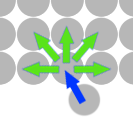 | (+) - Gives the player an opportunity to take another step. |
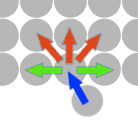 | (-) - Prohibits an opponent to take a step forward for the next move. (only on the sides) |
Innocently enough, but under certain circumstances and in combination with what will be discussed further, it can produce unexpected results.
Lady
It's all a bit more complicated. The map should not be very strong, because there are still three gradations of the power of skills ahead, but at the same time it should be quite useful. I conceived Damu how to use a map that allows you to manipulate closed cards on already completed rows, but in this case it will be much more difficult to think about the “negative” effect, because it must have a connection with opponents.
I see in this case only one way out of the situation. And it seems to me to be very unbalanced in perspective. But oh well. We will work on the bugs after the tests. Dame is also the first card in which I entered the "trigger" mode. When the active card is rotated, the mode is activated. The rest will describe. Triggers will be different.
 | (+) - The player can open one of the closed cards on the already completed rows. If the active card is open, turn it and play it on your next turn, as if it was opened during it. Deploy the card back after it. If a dummy is open, your turn is over. |
 | (-) - The opponent can open one of the closed cards on the already completed rows. If the active card is open - turn the lady and this card. The opponent in his next move cannot play this type of card. Turn the cards back after him. If a dummy is open, your turn is over. |
The standard analogue of the spell "dumb", if we draw an analogy with the magic theme.
King
The king has the destructive power that allows him to manipulate the playing field itself. He can help the player to lay a bridgehead for victory through the course, or prevent the enemy from reaching the point he needs so quickly.
Over the King, I thought the longest.
On the one hand, I really wanted to put an asset into the game, which would allow the player to think out his tactics more than one move ahead. On the other hand, it was necessary to connect opposing skills with each other. My connection is interaction with two cards. But I feel that the skill of kings will be the first to be recycled. Although this is just my feeling.
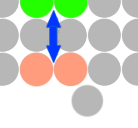 | (+) - Choose any two cards already open on the field, turn them face up and swap them with two cards in a row in front of you. Stir this row. (updated maps in the selected row remain closed for you) |
 | (-) - Choose any two cards from the hole cards on the field and take them out of the game. |
Ace
The only "no character" card. This fact immediately brought me to the idea of how to use it. There was even no questions.
 | (+) - Turn the ace. Strengthen your next red skill or weaken the next black opponent skill. Turn card back after use. |
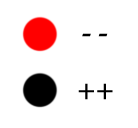 | (-) - Turn the ace. Strengthen your next black skill or weaken your opponent's next red skill. Turn card back after use. |
Your chip, which is on a rotated card, will always be able to remind you what needs to be done in your turn or that of your opponent. It's all quite simple. And finally - the final part.
Joker
Our jester with you is on the field in the amount of only two pieces. I think that you yourself can figure out with what chance a player can activate this card. Therefore, reflecting on the so-called "final" technique, which can complete the game with the help of a magic combo, I was guided by the tactical ability to use any spell, but with restrictions.
The thought found itself, roughly speaking.
(+) - Turn the joker. On your next turn, play any open red card. Turn the cards back after that turn.
(-) - Turn the joker. Play your open black card the next turn. Turn the cards back after that turn.
Exceptions and Reservations
My teacher in high school always said that while working on a project, always “focus on the fool when testing. The most ridiculous request can always drop the program. ” The game design is really the same. And it is for this reason that I will now describe general additional reservations that will help the game not to “hang on” at the most interesting point.
- The Black King, reinforced with an Ace, draws 4 cards from the game. At the same time, no more than three can be derived from one row.
- An Ace-strengthened Red Lady with a successful showdown allows you to play two active cards in a row on the next turn.
- Rotated cards are played immediately to the next turn before the start of movement, unless otherwise stipulated.
- A Black Jack reinforced with an Ace can “freeze” on the line either one opponent twice (two turns) or two different opponents.
- A Black Lady reinforced with an Ace can prohibit the use of two types of active cards for one opponent, or one type for each with a different showdown.
This list, of course, will be updated as further testing.
I think for the first part of all of the above is enough. 6 hours flew by.
Conclusion
Game design is probably the best manifestation of human creativity, which combines several different aspects related in one way or another to human perception, which only motivates learning, because some of the knowledge gained from studying the game design literature will be completely useful. in ordinary life.
If you, dear habrovchane, suddenly have free time, then try my creation in business. I will be happy to hear feedback, comments, advice and anything else on the subject that may seem interesting.
For sim otklanivayus.
The next part, as soon as I get there, will be about updates, potential card design and additional ideas that will help make the gameplay even more interesting!
Well, there is already close to the software implementations.
Table of contents:
- First part: Starting from scratch.
- The second part: From the skeleton to the muscles.
Source: https://habr.com/ru/post/195154/
All Articles